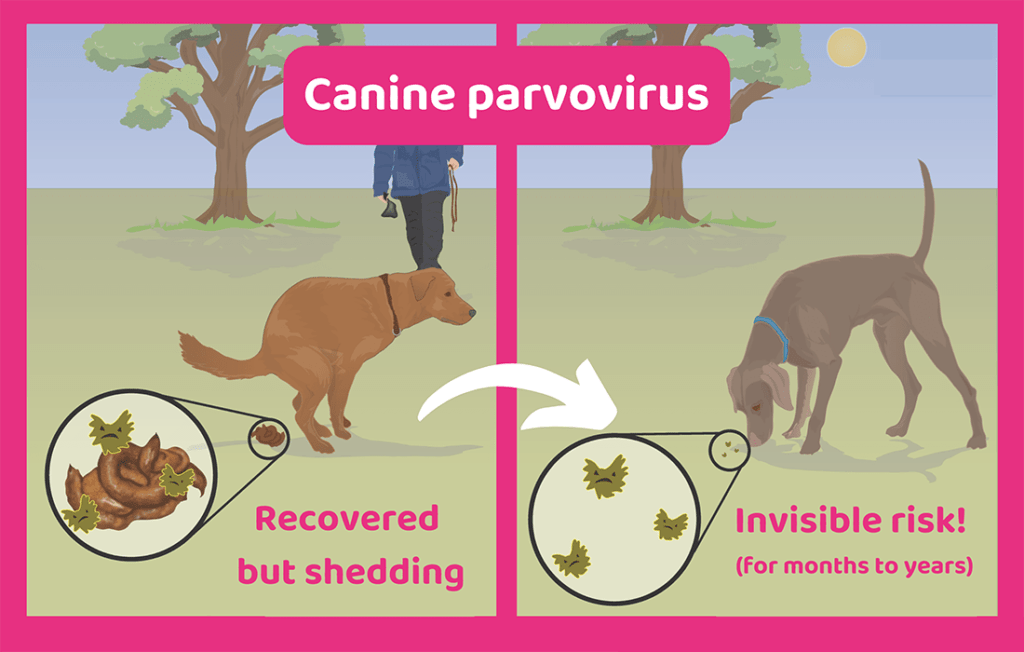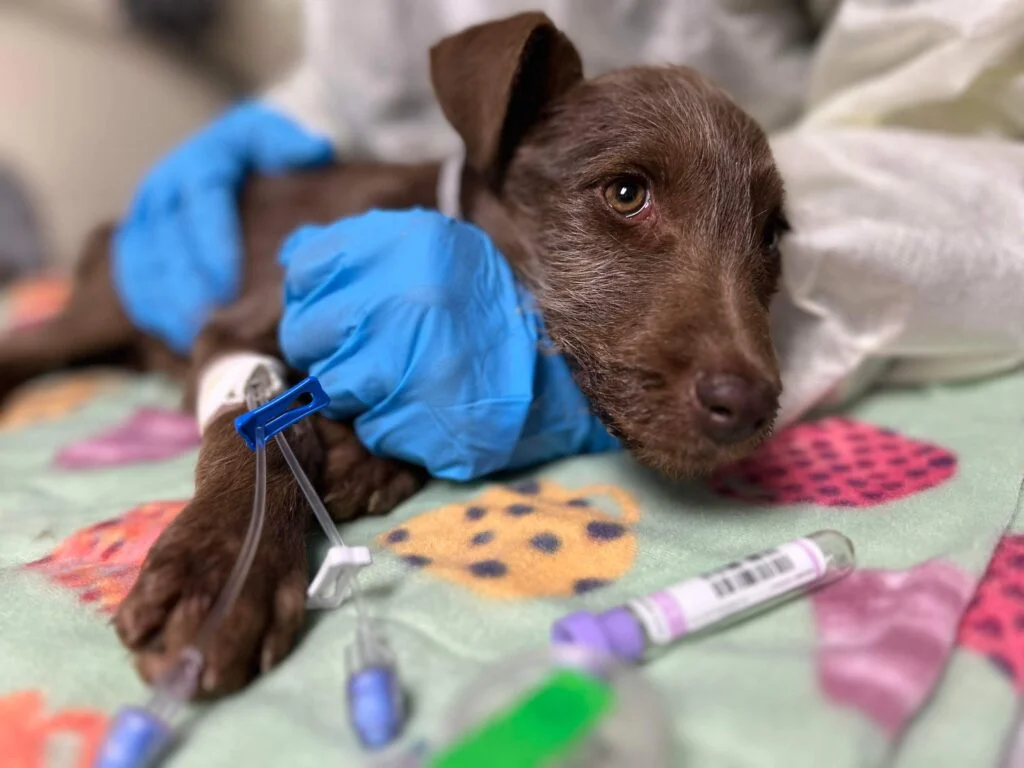Panoramica

Cos'è il parvovirus?
Il parvovirus (noto anche come parvo, parvovirus canino o CPV) è un virus che causa gravi malattie e morte nei cani. Danneggia il rivestimento dell'intestino, provocando vomito e diarrea gravi. Attacca anche le cellule che combattono le infezioni all'interno del midollo osseo, indebolendo il sistema immunitario rendendo molto difficile il recupero dei cani. Il parvovirus è particolarmente grave nei cani e nei cuccioli non vaccinati di età inferiore ai sei mesi perché il loro sistema immunitario non è ben sviluppato e quindi sono meno capaci di combattere il virus.

Come fanno i cani a contrarre la parvo?
La maggior parte dei cani contrae il parvovirus mentre sono in esplorazione. Viene versato nelle feci dei cani infetti tre o quattro giorni dopo che sono stati infettati, poi per un paio di settimane dopo che i sintomi si sono risolti. Sfortunatamente, può sopravvivere nell’ambiente per mesi o anni, il che significa che può essere trovato quasi ovunque vadano i cani, come giardini, parchi e campi. Può anche viaggiare nello sporco, quindi può essere trovato sulla suola delle scarpe, all'interno delle case, sui guinzagli dei cani, sui collari, sulle ciotole, sui vestiti, sui giocattoli e persino sulle mani umane.
La maggior parte dei cani sono esposti al parvovirus ad un certo punto della loro vita, quindi l'unico modo per proteggerli è attraverso la vaccinazione regolare.

Sintomi di parvo nei cani?
I sintomi del parvovirus di solito impiegano dai tre ai sette giorni per manifestarsi e includono:
Diagnosi del parvovirus nei cani?
Il test per la parvoparvo non è sempre necessario perché i sintomi sono generalmente molto evidenti. Tuttavia, se necessario, può essere diagnosticato utilizzando un rapido test delle feci che fornisce un risultato in circa 15 minuti. Questo test è solitamente molto accurato, ma se il risultato non è quello che il tuo veterinario si aspettava, potrebbe volerlo controllare inviando un po' di cacca a un laboratorio.
Il veterinario potrebbe anche eseguire esami del sangue per controllare i livelli delle cellule che combattono le infezioni e per verificare l'anemia dovuta alla perdita di sangue.
Quali sono le opzioni di trattamento?
Non esiste una cura, quindi i cani affetti da parvovirus necessitano di cure molto intensive e di farmaci per controllare i sintomi mentre il loro corpo cerca di combattere l'infezione. Il trattamento di solito include:
Prendersi cura di un cane che si sta riprendendo dal parvovirus?
Se il tuo cane si è ripreso abbastanza per tornare a casa, dovrai continuare ad allattarlo mentre si riprende completamente:
Il mio cane sopravvivrà alla parvo?
Le possibilità del tuo cane di sopravvivere al parvovirus sono molto più alte se lo porti dal veterinario non appena noti i sintomi. I cani che ricevono cure intensive tempestive mentre sono ricoverati in uno studio veterinario hanno molte più probabilità di sopravvivere ma, sfortunatamente, a causa della gravità del parvovirus, alcuni muoiono anche dopo il trattamento. Il parvovirus è quasi sempre fatale senza trattamento. I cuccioli corrono maggiori rischi di morire, soprattutto quelli di età inferiore a due settimane.
Quando contattare il veterinario?
Contatta immediatamente il veterinario se il tuo cane mostra sintomi di parvovirus. Fai sapere loro che pensi che potrebbe essere parvo e aspetta fuori dalla clinica finché il tuo cane non viene chiamato per evitare di trasmetterlo ad altri cani nella sala d'attesa.
Non è necessario contattare il veterinario se il tuo cane è semplicemente entrato in contatto con il parvovirus, basta monitorarlo attentamente per i sintomi e chiamare il veterinario per un consiglio se sei preoccupato.
Prevenire il parvovirus?
Vaccinazioni – il modo migliore e unico per prevenire l’infezione da parvovirus è vaccinare regolarmente il tuo cane. Avranno bisogno di due o tre vaccini contro il parvovirus mentre sono cuccioli, quindi di richiami regolari per il resto della loro vita.
Acquistare/ristrutturare in modo responsabile – acquista sempre da un allevatore responsabile o da un centro di reinserimento rispettabile. Assicurati di vedere il tuo cucciolo e i suoi fratelli con la mamma, nel luogo in cui sono cresciuti, in più di un'occasione. Tutti i cuccioli dovrebbero essere sani e luminosi senza segni di malattia e la loro mamma dovrebbe essere in regola con i suoi vaccini.
Portare fuori un nuovo cucciolo – I cuccioli non vaccinati e quelli che hanno ricevuto solo la prima iniezione corrono il rischio di contrarre il parvovirus. Il tuo cucciolo potrà uscire a fare una passeggiata e incontrare altri cani una o due settimane dopo aver completato il primo ciclo di vaccinazione, quindi fino ad allora segui i consigli di seguito:
Il costo del trattamento del parvovirus?
Il parvovirus può costare centinaia, se non migliaia di dirham da trattare perché la maggior parte dei cani richiede diversi giorni di trattamento intensivo in un ospedale veterinario. È importante parlare apertamente con il veterinario delle tue finanze, del costo del trattamento e di ciò che ritieni sia giusto per il tuo cane.
Quanto tempo dovrei aspettare per avere un cucciolo dopo aver perso un cane a causa del parvovirus?
Se di recente hai perso un cane a causa del parvovirus, il virus sopravviverà nella tua casa e nel tuo giardino per molto tempo. Può rimanere nell’ambiente per mesi o anni ed è quasi impossibile assicurarsi di eliminarlo del tutto, soprattutto nelle aree difficili da disinfettare come il giardino. Ciò significa che tutti i cani/cuccioli non vaccinati che vengono a casa tua sono a rischio di contrarre il parvovirus.
Se stai pensando di prendere un nuovo cucciolo, ti consigliamo di attendere finché non saranno completamente vaccinati prima di portarli a casa (dovrai assicurarti che siano adeguatamente socializzati dall'allevatore/centro di salvataggio). Se questa non è un'opzione, puoi ridurre il rischio che contraggono il parvovirus disinfettando accuratamente la tua casa e tenendoli fuori dal tuo giardino finché non saranno completamente vaccinati: parla con il tuo veterinario per ulteriori consigli e leggi di seguito come disinfettare il parvovirus.
Come disinfettare dopo il parvovirus?
È importante disinfettare completamente tutte le aree che sono state contaminate dal parvovirus.
La candeggina può uccidere il parvovirus se utilizzata correttamente. È facilmente reperibile ed è relativamente economico, ma presenta alcuni inconvenienti. Può scolorire o addirittura rovinare le superfici. I fumi possono essere irritanti per il naso, gli occhi e la pelle.
Per uccidere il parvovirus canino su superfici dure non porose, preparare una soluzione di candeggina con acqua. Prelavare le aree, quindi asciugare o pulire con la soluzione disinfettante. Lasciare riposare per dieci minuti, quindi risciacquare abbondantemente e asciugare all'aria. Un trattamento dovrebbe uccidere il virus purché si utilizzi la diluizione adeguata e si conceda dieci minuti di tempo di contatto. Per questa situazione, utilizzeremmo anche una bottiglia di candeggina appena acquistata per essere sicuri che il principio attivo della candeggina abbia la concentrazione indicata sull'etichetta. Non usare una bottiglia di candeggina rimasta lì per troppo tempo, perché col tempo la candeggina si decompone naturalmente in sale e acqua.
Ottieni risposte alle domande più comuni sul parvovirus.

| Biscotto | Durata | Descrizione |
|---|---|---|
| cookielawinfo-checkbox-analytics | 11 mesi | This cookie is set by GDPR Cookie Consent plugin. The cookie is used to store the user consent for the cookies in the category "Analytics". |
| cookielawinfo-checkbox-funzionale | 11 mesi | The cookie is set by GDPR cookie consent to record the user consent for the cookies in the category "Functional". |
| cookielawinfo-checkbox-necessario | 11 mesi | This cookie is set by GDPR Cookie Consent plugin. The cookies is used to store the user consent for the cookies in the category "Necessary". |
| cookielawinfo-checkbox-altri | 11 mesi | This cookie is set by GDPR Cookie Consent plugin. The cookie is used to store the user consent for the cookies in the category "Other. |
| cookielawinfo-checkbox-performance | 11 mesi | This cookie is set by GDPR Cookie Consent plugin. The cookie is used to store the user consent for the cookies in the category "Performance". |
| visti_cookie_policy | 11 mesi | Il cookie viene impostato dal plug-in GDPR Cookie Consent e viene utilizzato per memorizzare se l'utente ha acconsentito o meno all'uso dei cookie. Non memorizza alcun dato personale. |
Crea un account o accedi per salvare gli animali che ami.
Non hai un account? Contattaci
Prima di procedere con la richiesta di adozione, esamina e accetta le nostre pratiche di gestione dei dati:
Nota: By clicking "I Agree & Continue", you will be redirected to an external application form. This tracking system logs your interest but does not capture data from the external form.
Crea un account o accedi per salvare gli animali che ami.
Non hai un account? Contattaci
Prima di procedere con la richiesta di adozione, esamina e accetta le nostre pratiche di gestione dei dati:
Nota: By clicking "I Agree & Continue", you will be redirected to an external application form. This tracking system logs your interest but does not capture data from the external form.